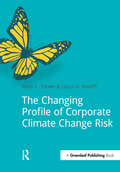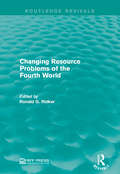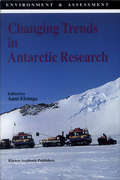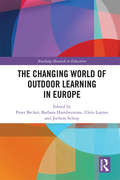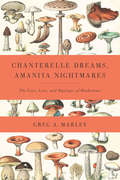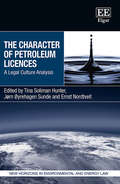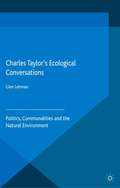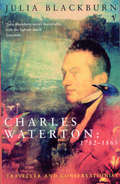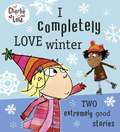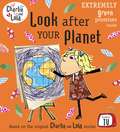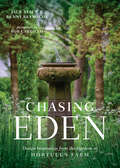- Table View
- List View
Changing Forests: Collective Action, Common Property, and Coffee in Honduras
by Catherine M. TuckerDrawing on ethnographic and archival research, this book explores how the indigenous Lenca community of La Campa, Honduras, has conserved and transformed their communal forests through the experiences of colonialism, opposition to state-controlled logging, and the recent adoption of export-oriented coffee production. The book merges political ecology, collective-action theories, and institutional analysis to study how the people and forests have changed through various transitions.
The Changing Profile of Corporate Climate Change Risk
by Mark Trexler Laura KosloffThis book will help business executives to (1) rethink their perceptions of climate risk (2) evaluate whether their company is effectively positioned, and (3) make informed and prudent business decisions about climate change risk in an environment rife with policy uncertainty.Business risk associated with climate change is commonly assumed to be primarily policy driven. Many companies internalize the current stalemate over global climate policy into a perception that climate risk is no longer a critical issue. Business climate risks, however, include: Operational and Supply Chain (Physical) Risk, Brand Risk, Market-driven Structural Risk, Liability Risk.As national and global policy to materially reduce climate change is delayed, it is business-prudent to assume that the level of climate risk is increasing. Even if policy risk might seem lower today than a few years ago, political will can change quickly. Should physical impacts of climate change manifest in dramatic ways, for example, draconian climate policy is likely to follow quickly. These conditions create a complex and shifting business risk environment, and most companies either overlook or substantially underestimate key climate risks. How many companies, for example, are positioned for material climate change outcomes, whether physical or regulatory? Companies with little climate change exposure may not face much downside risk from taking a wait-and-see approach. For those with greater exposure, being "too late" to respond will mean costs and competitive impacts that could have been avoided. Being "too early," however, can mean being penalized later for actions that reduce a company’s emissions today, or competitive disadvantage from getting too far out in front of competitors.
The Changing Profile of Corporate Climate Change Risk
by Mark Trexler Laura KosloffThis book will help business executives to (1) rethink their perceptions of climate risk (2) evaluate whether their company is effectively positioned, and (3) make informed and prudent business decisions about climate change risk in an environment rife with policy uncertainty.Business risk associated with climate change is commonly assumed to be primarily policy driven. Many companies internalize the current stalemate over global climate policy into a perception that climate risk is no longer a critical issue. Business climate risks, however, include: Operational and Supply Chain (Physical) Risk, Brand Risk, Market-driven Structural Risk, Liability Risk.As national and global policy to materially reduce climate change is delayed, it is business-prudent to assume that the level of climate risk is increasing. Even if policy risk might seem lower today than a few years ago, political will can change quickly. Should physical impacts of climate change manifest in dramatic ways, for example, draconian climate policy is likely to follow quickly. These conditions create a complex and shifting business risk environment, and most companies either overlook or substantially underestimate key climate risks. How many companies, for example, are positioned for material climate change outcomes, whether physical or regulatory? Companies with little climate change exposure may not face much downside risk from taking a wait-and-see approach. For those with greater exposure, being "too late" to respond will mean costs and competitive impacts that could have been avoided. Being "too early," however, can mean being penalized later for actions that reduce a company’s emissions today, or competitive disadvantage from getting too far out in front of competitors.
Changing Representations of Nature and the City: The 1960s-1970s and their Legacies (Routledge Advances in Art and Visual Studies)
by Gabriel N. Gee Alison VogelaarThe turn of the 1960s-70s, characterized by the rapid acceleration of globalization, prompted a radical transformation in the perception of urban and natural environments. The urban revolution and related prospect of the total urbanisation of the planet, in concert with rapid population growth and resource exploitation, instigated a surge in environmental awareness and activism. One implication of this moment is a growing recognition of the integration and interconnection of natural and urban entities. The present collection is an interdisciplinary inquiry into the changing modes of representation of nature in the city beginning from the turn of the 1960s/70s. Bringing together a number of different disciplinary approaches, including architectural studies and aesthetics, heritage studies and economics, environmental science and communication, the collection reflects upon the changing perception of socio-natures in the context of increasing urban expansion and global interconnectedness as they are/were manifest in specific representations. Using cases studies from around the globe, the collection offers a historical and theoretical understanding of a paradigmatic shift whose material and symbolic legacies are still accompanying us in the early 21st century.
Changing Representations of Nature and the City: The 1960s-1970s and their Legacies (Routledge Advances in Art and Visual Studies)
by Gabriel N. Gee Alison VogelaarThe turn of the 1960s-70s, characterized by the rapid acceleration of globalization, prompted a radical transformation in the perception of urban and natural environments. The urban revolution and related prospect of the total urbanisation of the planet, in concert with rapid population growth and resource exploitation, instigated a surge in environmental awareness and activism. One implication of this moment is a growing recognition of the integration and interconnection of natural and urban entities. The present collection is an interdisciplinary inquiry into the changing modes of representation of nature in the city beginning from the turn of the 1960s/70s. Bringing together a number of different disciplinary approaches, including architectural studies and aesthetics, heritage studies and economics, environmental science and communication, the collection reflects upon the changing perception of socio-natures in the context of increasing urban expansion and global interconnectedness as they are/were manifest in specific representations. Using cases studies from around the globe, the collection offers a historical and theoretical understanding of a paradigmatic shift whose material and symbolic legacies are still accompanying us in the early 21st century.
Changing Resource Problems of the Fourth World (Routledge Revivals)
by Ronald G. RidkerClimbing food, fertiliser and mineral prices as well as the Arab oil embargo in the seventies had severe economic consequences in developing countries. Originally published in 1976, this study explores the effects of these developments in the fourth world and how they can adjust to an international economy with a particular focus on resource availability in terms of energy and agriculture. This title will be of interest to students of Environmental Studies.
Changing Resource Problems of the Fourth World (Routledge Revivals)
by Ronald G. RidkerClimbing food, fertiliser and mineral prices as well as the Arab oil embargo in the seventies had severe economic consequences in developing countries. Originally published in 1976, this study explores the effects of these developments in the fourth world and how they can adjust to an international economy with a particular focus on resource availability in terms of energy and agriculture. This title will be of interest to students of Environmental Studies.
The Changing Status of Arable Habitats in Europe: A Nature Conservation Review
by Clive Hurford Phil Wilson Jonathan StorkeyThis edited volume documents the current nature conservation status of arable habitats in Europe. Arable farming systems have evolved in the European landscape over more than ten thousand years and now occupy nearly 30% of the European land area. They support species that have life cycles closely synchronised with traditional cereal growing, many of which have experienced massive declines throughout Europe. For example, in Britain, of the 100 plant species exhibiting the greatest declines in the latter half of the 20th century, 47 were typical of arable land. Despite this the habitat and many of the species associated with it remains unprotected across much of Europe. The 22 chapters cover a range of topics, including: · Regional accounts describing the impact of changing agricultural practices on the arable flora;· The results of research and surveillance projects on the soil organisms, bryophyte flora, invertebrate fauna and pollinators of arable habitats;· The potential for designing multifunctional and resilient agricultural landscapes; The use of ex situ conservation to aid the reintroduction of rare arable plants;· Case studies illustrating how changing agricultural practices have impacted on bird populations in Europe; · The roles of remote sensing in monitoring agricultural systems; · How agri-environment schemes can help restore the biodiversity in arable habitats; and · A look forward at ways to help ensure the future security of the species associated with arable habitats. It is clear that the biodiversity of arable land throughout Europe has undergone major changes, particularly during the second half of the 20th century, and that these changes are continuing into the 21st century. We need to develop a deeper appreciation of farmland wildlife and its integration into farming systems to ensure its future security in a world where value is increasingly expressed in terms of material profit. This book is particularly relevant to practitioners, policy-makers and managers working in the fields of nature conservation, agri-environment schemes and land management, and to researchers working in the fields of conservation biology, terrestrial ecology, nature conservation, applied ecology, biodiversity, agriculture, agricultural ethics and environmental studies.
Changing Trends in Antarctic Research (Environment & Assessment #3)
by AantElzingaThe core of this volume is a report from a symposium held at the University of Goteborg in the Fall of 1991. It deals with the interplay of science and politics and how^ such interplay affects research agendas. The focus is on polar research in Antarctica, a continent that has been much in the news during the past couple of years. It gives me particular pleasure to thank all the speakers who took part in the program. All of them have many commitments and involvements in international polar research and the protection of Antarctica for its scientific and aesthetic values. The fact that such a distinguished group has been willing to come to Goteborg, to my mind attests to the importance and timeliness of our topic and the relevance of epistemological and policy issues in this field. A presentation of each speaker and author is made within the relevant chapters in the text. My interest in the Antarctic has its origins in discussions with Anders Karlqvist, the Director of the Swedish Polar Research Secretariate at the Royal Academy of Science in Stockholm. Anders and I had worked together in the early 80's in a program on Technology and Culture, among other at the Research Policy Institute in Lund. At the time he was with the Swedish Council for Planning and Coordination of Research (FRN), its Committee for Future Oriented Research headed by Torsten Hagerstrand.
The Changing World of Outdoor Learning in Europe (Routledge Research in Education)
by Peter Becker Barbara Humberstone Chris Loynes Jochem SchirpThe Changing World of Outdoor Learning in Europe sets out to provide a comprehensive analysis of the economical and political changes that have occurred in European outdoor culture in the preceding two decades, from a diverse range of perspectives including institutional, theoretical, national and educational views. The book looks at how outdoor education has been transformed into an increasingly global field where established and influenced practices have been introduced into modernising and democratising nations. With contributions from the members of the board of the European Institute of Outdoor Adventure Eduation and Experiential Learning and representatives of the networks that stand behind it, this unique book provides thorough factual analyses and examinations of outdoor learning that have never been presented before. The book contains contributions from across Europe, with authors from the UK, Germany, Finland, Sweden, Slovenia, Poland, Norway and the Czech Republic. Chapters within the volume by non - European authors provide another perspective on the European story in a wider context. As a whole, the book will stimulate the ongoing debate about the nature, function and organisation of outdoor education around the globe. The Changing World of Outdoor Learning in Europe will be of great interest to academics, researchers and postgraduate students in the fields of outdoor education, leadership and recreation; and outdoor, sport, environmental and leisure studies. It should also be essential reading for those involved in outdoor organisations in Europe and worldwide.
The Changing World of Outdoor Learning in Europe (Routledge Research in Education)
by Peter Becker Barbara Humberstone Chris Loynes Jochem SchirpThe Changing World of Outdoor Learning in Europe sets out to provide a comprehensive analysis of the economical and political changes that have occurred in European outdoor culture in the preceding two decades, from a diverse range of perspectives including institutional, theoretical, national and educational views. The book looks at how outdoor education has been transformed into an increasingly global field where established and influenced practices have been introduced into modernising and democratising nations. With contributions from the members of the board of the European Institute of Outdoor Adventure Eduation and Experiential Learning and representatives of the networks that stand behind it, this unique book provides thorough factual analyses and examinations of outdoor learning that have never been presented before. The book contains contributions from across Europe, with authors from the UK, Germany, Finland, Sweden, Slovenia, Poland, Norway and the Czech Republic. Chapters within the volume by non - European authors provide another perspective on the European story in a wider context. As a whole, the book will stimulate the ongoing debate about the nature, function and organisation of outdoor education around the globe. The Changing World of Outdoor Learning in Europe will be of great interest to academics, researchers and postgraduate students in the fields of outdoor education, leadership and recreation; and outdoor, sport, environmental and leisure studies. It should also be essential reading for those involved in outdoor organisations in Europe and worldwide.
Chanterelle Dreams, Amanita Nightmares: The Love, Lore, and Mystique of Mushrooms
by Greg Marley2011 Winner, International Association of Culinary Professionals Jane Grigson Award2011 Finalist, International Association of Culinary Professionals in the Culinary History categoryThroughout history, people have had a complex and confusing relationship with mushrooms. Are fungi food or medicine, beneficial decomposers or deadly "toadstools" ready to kill anyone foolhardy enough to eat them? In fact, there is truth in all these statements. In Chanterelle Dreams, Amanita Nightmares, author Greg Marley reveals some of the wonders and mysteries of mushrooms, and our conflicting human reactions to them. With tales from around the world, Marley, a seasoned mushroom expert, explains that some cultures are mycophilic (mushroom-loving), like those of Russia and Eastern Europe, while others are intensely mycophobic (mushroom-fearing), including, the US. He shares stories from China, Japan, and Korea-where mushrooms are interwoven into the fabric of daily life as food, medicine, fable, and folklore-and from Slavic countries where whole families leave villages and cities during rainy periods of the late summer and fall and traipse into the forests for mushroom-collecting excursions. From the famous Amanita phalloides (aka "the Death Cap"), reputed killer of Emperor Claudius in the first century AD, to the beloved chanterelle (cantharellus cibarius) known by at least eighty-nine different common names in almost twenty-five languages, Chanterelle Dreams, Amanita Nightmares explores the ways that mushrooms have shaped societies all over the globe. This fascinating and fresh look at mushrooms-their natural history, their uses and abuses, their pleasures and dangers-is a splendid introduction to both fungi themselves and to our human fascination with them. From useful descriptions of the most foolproof edible species to revealing stories about hallucinogenic or poisonous, yet often beautiful, fungi, Marley's long and passionate experience will inform and inspire readers with the stories of these dark and mysterious denizens of our forest floor.
The Chaos Point: The world at the crossroads
by Ervin LaszloWe have a choice: Breakdown or Breakthrough. In THE CHAOS POINT revered author and systems theorist Ervin Laszlo tells us that we are at a critical juncture in history, a 'decision-window' where we face both the danger of global collapse and the opportunity of worldwide renewal. According to Laszlo we have six to seven years to head off unsustainable trends that would lead to a 'tipping point' beyond which there is no turning back. After this tipping point we either evolve to a safer, more sustainable world, or the social, economic and ecological systems that frame our life break down. This is the Chaos Point, but this need not be the end of the world, only the end of a phase of the world beyond which a new world could dawn. In today's decision-window we have a unique chance of creating that new world and this pioneering book tells us what healing and renewal means, and how each of us can help in achieving it.
The Character of Petroleum Licences: A Legal Culture Analysis (New Horizons in Environmental and Energy Law series)
This innovative book explores the legal character of petroleum licences, a key vehicle governing the relationship between oil companies and their host states. Examining the issue through the lens of legal culture, it illustrates why some jurisdictions exert strong state control and others only minimal. Critically investigating the nature of a petroleum licence, the book analyses whether it is a mere administrative right, a contract or something more akin to property rights. Chapters examine recent developments, such as the UK’s strategy of maximizing economic recovery and the opposition to drilling for oil in Norway and Australia. Outside of Western petroleum jurisdictions, the book also explores several long-established jurisdictions including Russia and Mexico, as well as emerging jurisdictions, such as China and Uganda. Taking a contextual and system-oriented approach, it reveals the preconditions of the petroleum licence regime and offers a critical insight into the reasons behind alterations to the terms of the licences. Encompassing a wide variety of legal cultures and experiences, this thought-provoking book will prove to be a valuable resource for academics and students of energy law, particularly those with an interest in state regulation. It will also provide useful insights for industry-based practitioners.
Charcoal Making in Developing Countries (Routledge Library Editions: Forestry)
by Gerald FoleyOriginally published in 1986, this book provides a detailed examination of programmes to introduce improved charcoal making techniques throughout the developing world. Charcoal making is widely regarded as an extremely wasteful use of scarce wood resources. The book includes a section on the physics and chemistry of charcoal and descriptions of the various traditional methods of charcoal making. Patterns of charcoal supply and distribution are analysed and efforts to introduce improved charcoal making techniques are described and evaluated.
Charcoal Making in Developing Countries (Routledge Library Editions: Forestry)
by Gerald FoleyOriginally published in 1986, this book provides a detailed examination of programmes to introduce improved charcoal making techniques throughout the developing world. Charcoal making is widely regarded as an extremely wasteful use of scarce wood resources. The book includes a section on the physics and chemistry of charcoal and descriptions of the various traditional methods of charcoal making. Patterns of charcoal supply and distribution are analysed and efforts to introduce improved charcoal making techniques are described and evaluated.
Charging Ahead
by Joe ShermanCharging Ahead is a classic tale of perseverance against daunting odds in the pursuit of a personal dream--and an environmental revolution. You'd have to be a fool to market a consumer electric car, let alone challenge the big three auto makers with a little start up company. But MIT graduate James Worden, with his girlfriend and a handful of audacious engineers, did both and he's well on his way to success. In this marvelous narrative, business writer Joe Sherman vividly describes how Worden and his team built the world's most advanced EV (electric vehicle), the Sunrise. Combining insightful biography with the best of science and business writing, Sherman captures not only Worden's own gripping story, but also the technical challenge of designing an electric car in an age of anxiety over the environment. He depicts Worden's fascination with EVs from childhood (he built his award winning first electric car in high school), tracing it through his monomaniacal career at MIT, where he organized a student team that built EVs for races worldwide, to the founding of Solectria, a company committed to building a consumer electric car. Sherman shows how, despite all the obstacles, Solectria eventually lined up such strategic partners as the Pentagon on its way to producing the Sunrise a lightweight, all-composite, high tech commuter car. The Sunrise would triumph over rivals from the Big Three in the 7th American Tour de Sol, and later travel from Boston to New York on a single battery charge. Charging Ahead is an engaging story of James Worden's struggle to succeed with idealism, energy, and technological superiority against seemingly impossible odds.
Charles Taylor’s Ecological Conversations: Politics, Commonalities and the Natural Environment
by Glen LehmanThe author uses the work of the eminent Canadian philosopher, Charles Taylor, to develop a critique of those political perspectives that are based on instrumental ways to reason about the world, claiming that such perspectives invariably sever the connections between the social and natural worlds.
Charles Waterton 1782-1865: Traveller and Conservationist
by Julia BlackburnCharles Waterton was the first conservationist who fought to protect wild nature against the destruction and pollution of Victorian industrialisation. During his lifetime he was famous for his eccentricities, but also for his achievements and his opinions. A Yorkshire landowner, he turned his park into a sanctuary for animals and birds. As an explorer he learned to survive in the tropical rain forests of South America without a gun or the society of other white men. He was an authority on the poisons used by South American Indians and a taxidermist of note. The huge public that read his books included Dickens, Darwin and Roosevelt. Since his death the memory of Waterton's personal eccenticities has flourished, while the originality of his ideas and work has often suffered. Using his surviving papers, Julia Blackburn has redressed the balance in a biogr aphy that restores Waterton to his place as the first conservationist of the modern age.
Charlie and Lola: I Completely Love Winter (Charlie and Lola)
by Lauren ChildCharlie has this little sister Lola. She is small and very funny...This really very good Charlie and Lola book includes two wintery stories: Snow is My Favourite and My Best and I Really Need Actual Ice Skates. This wonderful book is perfect for fans of Charlie and Lola, and for cold winter bedtimes.
Charlie and Lola: Look After Your Planet (Charlie and Lola)
by Lauren ChildLola is clearing out some of her old things because she does not want her bedroom to ever get as messy and pongy as Marv's older brother Marty's bedroom - yuk! Charlie persuades Lola that instead of throwing her things away, she should recycle them. 'Recycle it? What is that?' asks Lola. With a bit of help from Charlie, Lola learns all about recycling and how it is extremely very important to look after our planet. Soon she has found an extra-specially fun way to do more recycling - and gets lots of her classmates to join in too!
Charting Environmental Law Futures in the Anthropocene
by Michelle LimThis book explores a range of plausible futures for environmental law in the new era of the Earth’s history: the Anthropocene. The book discusses multiple contemporary and future challenges facing the planet and humanity. It examines the relationship between environmental law and the Anthropocene at governance scales from the global to the local. The breadth of issues and jurisdictions covered by the book, its forward-looking nature, and the unique generational perspective of the contributing authors means that this publication appeals to a wide audience from specialist academics and policy-makers to a broader lay readership.
Chasing Eden: Design Inspiration from the Gardens at Hortulus Farm
by Jack Staub Renny ReynoldsUsing their garden, Hortulus Farm in Bucks County, PA, as an example, celebrated gardeners and tastemakers Jack Staub and Renny Reynolds explain the principles of garden design, and give gardeners the courage to know when to break them.
Chasing Plants: Journeys with a Botanist through Rainforests, Swamps, and Mountains
by Chris ThorogoodFrom an acclaimed botanist and artist, a thrilling and beautifully illustrated expedition around the globe in search of the world’s most extraordinary plants. After making a strange discovery on a childhood trip to Ikea—a stand of sap-sucking, leafless broomrapes, stealing nutrients from their neighbors’ roots—Chris Thorogood dreamed of becoming a botanist and would stop at nothing to feed his growing addiction to plants. In his hair-raising adventures across Europe, Africa, the Middle East, and Asia, Thorogood treads a death-defying path over cliffs, up erupting volcanoes, through typhoons, and out into the very heart of the world’s vast, green wilderness. Along the way, he encounters pitcher plants, irises, and orchids more heart-piercingly beautiful than could ever be imagined. But with Thorogood as our guide in Chasing Plants, we not only imagine: we see. An internationally acclaimed botanical illustrator, Thorogood conjures his adventures spent seed-collecting and conserving plants around the world back to life in his electric paintings, which feature throughout the book. They bring plants out of the shadows, challenging us to see their intrigue and their character, and helping us to understand why plant species must be protected. To join Thorogood in his wild adventures is to be cast under his green spell: readers will never think of plants the same way again.
Chasing Plants: Journeys with a Botanist through Rainforests, Swamps, and Mountains
by Chris ThorogoodFrom an acclaimed botanist and artist, a thrilling and beautifully illustrated expedition around the globe in search of the world’s most extraordinary plants. After making a strange discovery on a childhood trip to Ikea—a stand of sap-sucking, leafless broomrapes, stealing nutrients from their neighbors’ roots—Chris Thorogood dreamed of becoming a botanist and would stop at nothing to feed his growing addiction to plants. In his hair-raising adventures across Europe, Africa, the Middle East, and Asia, Thorogood treads a death-defying path over cliffs, up erupting volcanoes, through typhoons, and out into the very heart of the world’s vast, green wilderness. Along the way, he encounters pitcher plants, irises, and orchids more heart-piercingly beautiful than could ever be imagined. But with Thorogood as our guide in Chasing Plants, we not only imagine: we see. An internationally acclaimed botanical illustrator, Thorogood conjures his adventures spent seed-collecting and conserving plants around the world back to life in his electric paintings, which feature throughout the book. They bring plants out of the shadows, challenging us to see their intrigue and their character, and helping us to understand why plant species must be protected. To join Thorogood in his wild adventures is to be cast under his green spell: readers will never think of plants the same way again.

